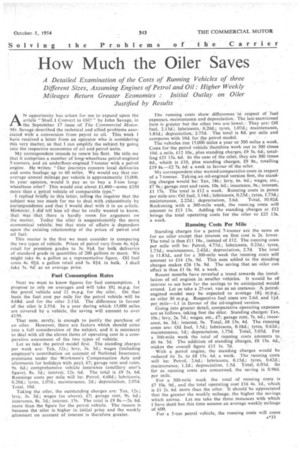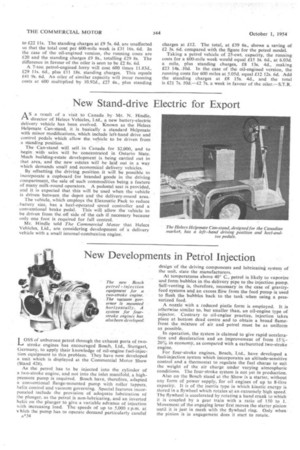How Much the Oiler Saves
Page 119

Page 120

If you've noticed an error in this article please click here to report it so we can fix it.
A Detailed Examination of the Costs of Running Vehicles of three Different Sizes, Assuming Engines of Petrol and Oil Higher Weekly Mileages Return Greater Economies : Initial Outlay on Oiler *Justified by Results
AN opportunity has arisen for me to "expand upon the article "Shall I Convert to Oil?" by John Savage, in the September 17 issue of The Commercial Motor. Mr, Savage described the technical and allied problems assot elated with a conversion from petrol to oil. This week I have received a letter from an operator who is considering this very matter, so that I can amplify the subject by going. into the respective economics of oil and petrol units.
, My correspondent intends to renew his fleet. He tells mc that it comprises a number of long-wheelbase petrol-engined 5-tonners, and an underfloor-engined 7-tonner with a petrol engine. He writes: "Our journeys concern local deliveries and some haulage up to 60 miles. We would say that our average annual mileage per vehicle is approximately 15,000. In your opinion, would it pay us to buy a 5-ton longwheelbase oiler? This would cost about £1,400-some £350 more than a petrol vehicle of comparable type."
I replied briefly to this letter, telling the inquirer that the subject was too Much for me to deal with exhaustively by correspondence and that I would deal with it in an article. However, I did tell him all that he really wanted to know, that was that there is hardly room for argument on the matter. Today. The oiler is unquestionably the more economical vehicle, but that state of affairs is dependent upon the existing relationship of the prices of petrol and oil fuel.
This matter is the first we must consider in comparing the two types of vehicle. Prices of petrol vary from 4s. 6.1d. retail for premium grades to 3s. 9id. for bulk deliveries of standard grade in quantities of 200 gallons or more. We might take 4s. a gallon as a representative figure. Oil fuel costs 4s. Oid. a gallon retail and 3s. 81d. in bulk. I shall take 3s. 901: as an average price.
Fuel Consumption Rates
Next we want to know figures for fuel consumption. l propose to rely on averages and will take 101 m.p.g. for the petrol vehicle and 21 m.p.g. for the oiler. On that basis the fuel cost per mile for the petrol vehicle will be 4.68d. and for the oiler 2.13d. The difference in favour of the oiler is 2.55d. In a year during which 15,000 miles are covered by a vehicle, the saving will amount to over £150.
That sum, surely, is enough to justify the purchase of an oiler. However, there are factors which should enter into a full consideration of the subject, and it is necessary to deal with all the eleven items of operating cost in a comparative assessment of the two types of vehicle.
• Let us take the petrol mcnO first. • The standing charges per week are: Tax, 12s.; levy, 3s. 3d.; wages (including employer's contribution on account of National Insurance, premiums under the Workmen's Compensation Acts and allotments for holidays With pay), £7; garage rent and rates, 9s. 6d.; comprehensive vehicle insurance (ancillary user's figure), 8s. 3d,; interest, 12s. 6d. The total is £9 5s. 6d. Runnings costs per mile will be: Petrol, 4.68d.; lubricants, 0.20d.; tyres, 1.07d.; maintenance, 2d.; depreciation, 2.05d.
Total, 10d. .
Taking the oiler, the outstanding charges are: Tax, 12s.; levy, 3s. 3d.; wages (as above), £7; garage rent, 9s. 6d.; insurance, 8s. 3d.; interest, 15s. The total is £9 8s.-2s. 6d. more than the figure for the petrol vehicle. The reason is because the oiler is higher in initial price and the weekly allotment on account of interest is therefore greater.
The running costs show differences -hi respect tsf 'fuel expenses, maintenance and depreciation._ The last-mentioned item is greater but the other two are lower.' They are: Oil fuel, 2.13d."; lubricants,. 0.20d.; tyres, 1.07d.; maintenance. 1.85d.; depreciation,2.75d. The total is 8d. per mile and compares with 10d. for the petrol model. The vehicles run 15,000 miles a year or 300 miles a week. Costs for'the petrol vehicle.therefore work out to 300 times 10d. a mile, £12 10s, plus standing charges, £9 5s. 6d:, totalling £21 15s. 6d. In the case of the oiler, they are 300 times 8d., which is £10, plus standing charges, £9 88., totalling £19 8s.-£2 7s. 6d. a week in favour of the oiler.
My correspondent also wanted comparative costs in respect of a 7-tonner. Taking an oil-engined version first, the standing charges would be: Tax, 18s.; levy, 6s. 6d.; wages, etc., £7 9s.; garage rent and Tates, 10s. 6d.; insurance, 9s.; interest, £1 17s. The total is £12 a week. Running costs in pence per mile are: Oil fuel, 3.14d.; lubricants, 0.23d.; tyres, 1.73d.; maintenance, 2.22d.; depreciation, 3.6d. Total, 10.92d. Reckoning with a 300-mile week, the running costs will amount to £13 13s. Adding the standing charges at £12 , brings the total operating costs for the oiler to £25 13s. a week.
Running Costs Per Mile
Standing charges for a petrol 7-tanner are the same as for an oiler except that interest on first cost is 2s. lower. The total is thus £11 18s., instead of £12. The running costs per mile will be: Petrol, 4.75d.; lubricants, 0.23d.; tyres, 1.73d.; maintenance, 2.42d.; depreciation, 2.7d. The total is 11.83d., and for a 300-mile week the running costs will amount to £14 15s. 9d. This sum added to the standing charges makes E26 13s. 9d. The saving that an oiler cart effect is thus Os. 9d. a week.
Recent months have revealed a trend towards the installation of oil engines in smaller vehicles. It would be of interest to see how far the savings to be anticipated would extend, Let us take a 25-cwt. van as an instance. A petrol. engined model may be expected to average 18i, an oiler 30 m.p.g. Respective fuel costs are 2.6d. and lid. per mile-1.1 in favour of the oil-engined version.
Going into greater detail, comparative operating expenses are as follows, taking first the Oiler, Standing charges; Tax, 10s.; levy, 2s. 7d.; wages, etc., £7; garage rent, 7s. 6d.; insurance, 6s. 3d.; interest, 9s. Total, £8 15s. 4d. The running costs are: Oil fuel, 1.5d.; lubricants, 0.18d.; tyres, 0.62d.; maintenance, Id.; depreciation, 1.75d, Total, 5.05d. For a 300-mile week the total of running .costs amounts to,
£6 6s. 3d. The addition of standing charges, £8 15s. 4d.,' Makes the overall figure £15 Is. 7d.
• With a petrol engine, the standing charges would be reduced by 2s. to £8 13s.4d. a week. The running costs will be: Petrol, 2.6d.; lubricants, 0.15d.; tyres, 0.62d.; maintenance, 1.2d.; depreciation, 1.5d. Total, 6.03d. So far as running costs are concerned, the saving is 0.98d. per mile. For a 300-mile week the total of running costs is £7 10s. 9d., and the 'total operating cost £16 4s. id., which is £1 2s. 6d. more than the oiler. It should be appreciated that the greater the weekly mileage, the higher the savings which accrue. Let me take the three instances with which I have dealt but this time assume an average weekly mileage of 600.
For a 5-ton petrol vehicle, the running costs will come A*33 to £22 1 is. The standing charges at £9 5s. 6d. are unaffected so that the total cost per 600-mile week is £31 16s. 6d. In the case of the oil-engined version, the running costs are £20 and the standing charges £9 8s., totalling £29 8s. The difference in favour of the oiler is seen to be £2 8s. 6d.
A 7-ton petrol-engined lorry will cost 600 times 11.83d., £29 1 Is. 6d., plus £11 18s. standing charges. This equals £41 9s. 6d. An oiler of similar capacity will incur running costs at 600 multiplied by 10.92d., £27 6s., plus standing charges at £12. The total, at £39 6s., shows a saving of £2 3s. 6d. compared with the figure for the petrol model.
Taking a petrol vehicle of 25-cwt. capacity, the running costs for a 600-mile week would equal £15 Is. 6d., at 6.03d, a mile, plus standing charges, £8 13s. 4d., making E23 14s. .10d. In thc case of the oil-engined version, the running costs for 600 miles at 5.05d. equal £12 12s. 6d. Add the standing charges at £8 15s. 4d., and the total is 121 7s. rod.—L2 7s. a week in favour of the oiler.—S.T.R.




























































































































































